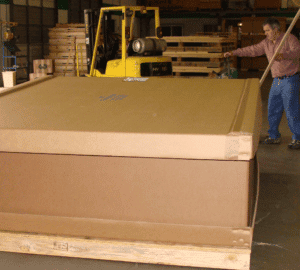Everything you need to know about cardboard
Here at Reid Packaging we’ve done our fair share of high tech military and aerospace jobs. For example, we packed up two F-22 assembly plants for Lockheed Martin. But just because we’re packing up fighter jets, valuable tools and parts, and extremely fragile items doesn’t mean we’re above using cardboard.
Yes, that’s right, cardboard.
Or, corrugated fiberboard aka: “corrugated.” Whatever name you give it, we use lots of it to package and protect valuable items in shipping and storage.
Because it’s such a useful material across a wide variety of applications, we thought it would be nice to dedicate a blog post to this trusty stuff.
Cardboard or Corrugated Fiberboard?
When you think of a brown shipping box, you probably call the material cardboard. But because cardboard also refers to heavy-duty cardstock, cereal box material, and poster-board, we prefer a more specific term in the industry. We call it corrugated fiberboard.
Corrugated fiberboard is constructed using at least one sheet of thick paperboard and least one corrugated (rippled) sheet.
So all corrugated fiberboard will look a little like this from the edge. And it comes in a variety of thicknesses and configurations.
How is it made?
Corrugated fiberboard is made by combining an outside layer of thick paperboard and an inside, corrugated layer. The inside layer comes from a different kind of paper pulp that is thinner and ripples easily. It’s manufactured with corrugators – large machines that process the material at high speeds without warping. The corrugated layer, known as the medium, gets its rippled (or fluted) pattern from a combination of heat, moisture and a process that involves small wheels that form the ripples. It is then glued to the paperboard sides with a starch-based glue.
What are the different types?
Of course, corrugated fiberboard comes in a variety of thicknesses for different types of applications.
[su_note note_color=”#f7f7f7″]
Single face corrugated fiberboard – just one layer of paperboard and one fluted board. This is the least protective type of packaging material, typically used just as a protective layer for an already packaged item.
Single wall or double face – This is the most common type of corrugated fiberboard and is typical in consumer shipping. It consists of two layers of paperboard on either side of a fluted layer. It comes in different thickness starting with C-flute (3/16th of an inch thick) and going down to F-flute (1/16th of an inch thick).
Double wall – This type of corrugated fiberboard is much more sturdy when shipping. It consists of two layers of fluted paper with three layers of paperboard (two on the outside and one in-between). It is often used for industrial shipments and more fragile materials.
Triple wall – It’s the heavy duty corrugated. This type of corrugated must necessarily be Herculean in strength. Consisting of three layers of fluted paper and four layers of paperboard, this is the sturdiest type of corrugated fiberboard there is.
Triple wall is often used as a substitute for wood crating and in the shipment of sensitive chemicals or industrial equipment. We build it to size, to shape, and in short runs or long. We fabricate triple wall like nobody’s business – our reputation was made at this high level of precision and protection. We make triple wall in house, where many don’t. It’s much harder to fabricate.
[/su_note]

Want to find out more about how we protect your valuable stuff? Wondering what combination of packaging materials would be perfect for your shipment? We can help, just give us a ring. 1-800-642-1823


